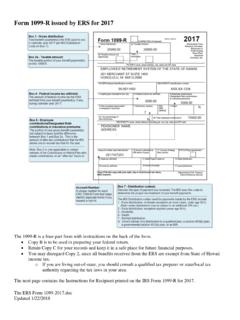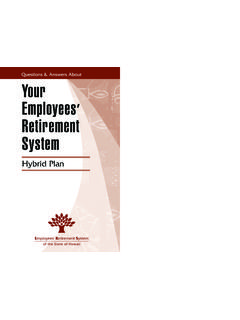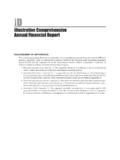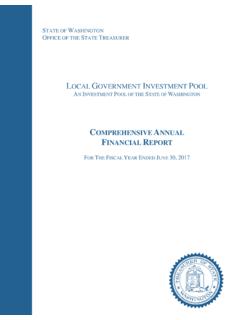Transcription of COMPREHENSIVE ANNUAL FINANCIAL REPORT - …
1 EMPLOYEES RETIREMENT SYSTEM OF THE STATE OF HAWAII COMPREHENSIVE ANNUAL FINANCIAL REPORT FOR THE FISCAL YEAR ENDED JUNE 30, 2016 This page intentionally left blank. EMPLOYEES RETIREMENT SYSTEM OF THE STATE OF HAWAII COMPREHENSIVE ANNUAL FINANCIAL REPORT FOR THE FISCAL YEAR ENDED JUNE 30, 2016 Prepared by the Staff of the: Employees' Retirement System of the State of Hawaii 201 Merchant Street, Suite 1400 Honolulu, Hawaii 96813 (808) 586-1735 (808) 586-1650 Facsimile (808) 586-1677 THOMAS WILLIAMS, Executive Director KANOE MARGOL, Deputy Executive Director VIJOY P. CHATTERGY, Chief Investment Officer Table of Contents INTRODUCTORY SECTION Letter of Transmittal 5 Board of Trustees 9 Organizational Structure 10 Plan Summary 11 Summary of Retirement Benefit Plan Provisions 12 Retirement Options 24 Legislative Highlights 2016 26 FINANCIAL SECTION Independent Auditors REPORT 28 Management s Discussion and Analysis 31 FINANCIAL Statements Combining Statement of Fiduciary Net Position 38 Statement of Changes in Fiduciary Net Position 39 Notes to FINANCIAL Statements 40 Required Supplementary Information (Unaudited)
2 Schedule of Changes in the Employers Net Pension Liability and Related Ratios 75 Schedule of Employers Net Pension Liability 76 Schedule of Employer Contributions 77 Schedule of Investment Returns 77 Notes to Required Supplementary Information 78 Supplementary Information Schedule 1 Combining Schedule of Changes in Fiduciary Net Position All Trust Funds 85 Schedule 2 - Social Security Contribution Fund, Statement of Changes in Assets and Liabilities 86 Schedule 3 Schedule of Administrative Expenses 87 Schedule 4 Schedule of Investment Expenses 88 INVESTMENT SECTION Letter from Chief Investment Officer 91 Letter from Investment Consultant 97 REPORT on Investment Activity by Investment Consultant Outline of Investment Policies 100 Asset Allocation 103 Investment Results 104 Investment Professionals 106 List of Largest Assets Directly Held 107 Investments Summary 108 Schedule of Investment Fees 108 Schedule of Broker Commissions 109 ACTUARIAL SECTION GASB Statement No.
3 67 REPORT from GRS 116 Summary of 2016 Actuarial Valuation Letter from the Actuary (Valuation) 121 Executive Summary (Valuation) 126 Actuarial Certification Statement 127 Exhibit 1 Development of Employer Cost 129 Exhibit 2 Actuarial Present Value of Future Benefits 130 Exhibit 3 Analysis of Normal Cost 131 Exhibit 4 Development of Actuarial Value of Assets 132 Exhibit 5 Total Experience Gain or Loss 133 Exhibit 6 Investment Experience Gain or Loss 134 Exhibit 7 Projection Results Based on the June 30, 2016 Actuarial Valuation 135 Exhibit 8 Highlights of Last Five ANNUAL Actuarial Valuations 136 Summary of Actuarial Assumptions and Methods 137 Summary of Plan Changes 150 Ten Year Actuarial Schedules, 2007 to 2016 Retirement System Membership 153 Membership Data, March 31.
4 2016 154 Historical Summary of Active Member Data 154 Pensioners, Average ANNUAL Pension, and Active Member/Pensioner Comparison 155 Number of Retirants and Beneficiaries 155 Solvency Test 156 Employer Contribution Rates as Percentage of Payroll 157 Employer Appropriations to Pension Accumulation Fund, Appropriation Years 2006-2007 to 2015-2016 158 State Retirement Systems' Funded Ratios 159 STATISTICAL SECTION Summary 162 Changes in Fiduciary Net Position 162 Contributions 163 Deductions from Fiduciary Net Position for Benefit Payments by Type 164 Participating Employers and Membership in ERS 165 Benefit Payments by Retirement Type and Option 166 Average Monthly Service Pension by Year of Credited Services 167 Retirees and Beneficiaries Tabulated by Fiscal Year of Retirement 168 Total Benefits Payable Tabulated by Attained Ages of Benefit Recipients 169 INTRODUCTORY SECTION 4 Introductory Section _____ _____ Employees Retirement System of the State of Hawaii This
5 Page intentionally left blank. _____ Introductory Section 5 Letter of Transmittal DAVID Y. IGE GOVERNOR THOMAS WILLIAMS EXECUTIVE DIRECTOR KANOE MARGOL DEPUTY EXECUTIVE DIRECTOR City FINANCIAL Tower 201 Merchant Street, Suite 1400 Honolulu, Hawaii 96813-2980 Telephone (808) 586-1735 Fax (808) 586-1677 COMPREHENSIVE ANNUAL FINANCIAL REPORT 2016 STATE OF HAWAII EMPLOYEES RETIREMENT SYSTEM November 29, 2017 Board of Trustees Employees Retirement System of the State of Hawaii Dear Board Members: We present the COMPREHENSIVE ANNUAL FINANCIAL REPORT (CAFR) of the Employees Retirement System for the fiscal year ended June 30, 2016. Responsibility for both the accuracy of the data, as well as the completeness and fairness of the presentation, rests with the management of the ERS.
6 We trust that you and the members of the ERS will find this REPORT useful in understanding your retirement system. BACKGROUND The ERS was established by the Legislature in 1925 to administer a retirement, disability, and survivor benefits program for State and county employees including teachers, professors, police officers, firefighters, judiciary employees, judges, and elected officials. The ERS is a qualified defined benefit public pension plan covered under Section 401(a) of the Internal Revenue Code. Hawaii Revised Statutes Chapter 88 and Hawaii Administrative Rules Title 6, Chapters 20 29 contain the language governing the pension trust. The ERS covers all eligible full-time and part-time State and county employees in the State of Hawaii. The ERS uses the entry age normal funding method to determine its current and future costs and appropriateness of its funding requirements.
7 Funding for benefit payments comes from employer and member contributions, and investments. Members of the Pension Trust belong to either the Contributory, Hybrid (a contributory class), or Noncontributory Class. Contributory and Hybrid Members make employee contributions to the Pension Trust and employers make contributions for employees of all three classes. Since 2006 most new employees of participating employers in the Pension Trust are required to join the Hybrid Class, except for certain employee groups that are required to be members of the Contributory Class. New benefit structures were established in 2011 for new members hired after June 30, 2012. On March 31, 2016 the ERS total membership of 135,178 was comprised of 67,377 active members, 45,506 retirees and beneficiaries 7,741 inactive vested members and 14,554 inactive non-vested members.
8 This compares to 120,624 under historical methodology used in the actuarial valuation that excludes inactive non vested members. Participating employers include the State of Hawaii, City and County of Honolulu, and the counties of Hawaii, Maui, and Kauai. 6 Introductory Section _____ Letter of Transmittal (continued) _____ Employees Retirement System of the State of Hawaii The ERS is also responsible for the custody of the Social Security Contribution Fund for the State of Hawaii. The Social Security contributions withheld from employees are remitted directly to the Internal Revenue Service by the State. As an agency type fund that is custodial in nature, the ERS has limited discretion in the management of this fund. MAJOR ACCOMPLISHMENTS AND INITIATIVES IN FY 2016 During FY 2016, the ERS continued to focus on reforms to better structure the pension plan to meet its long-term pension obligations for current and future members, retirees and beneficiaries.
9 The ERS completed a Five-Year Experience Study with our actuary and adopted new actuarial assumptions for the ERS valuation based on the their recommendations from the study, completed the 2015 Asset Liability Study with our investment consultant and updated the long-term asset allocation policy based on the results of this study, and introduced legislation to improve the cash flow of ERS. The ERS ended the fiscal year with net assets at $ billion based on ERS investment portfolio returns (gross of fees, time weighted rate of return) for the fiscal year. The Board of Trustees adopted new actuarial assumptions based on the recent actual results of 2010-2015 Five Year Experience Study, that combined with ERS actual results of FY 2016 resulted in the Net Pension Liability (NPL) increasing to $ billion as of June 30, 2016 from $ billion as of June 30, 2015 with corresponding funded ratio decrease to from , respectively.
10 The main changes in the actuarial assumptions (effective June 30, 2016) that affected the NPL increase are lowering the investment return assumption from to and increasing life expectancy of the ERS membership. (A complete list of assumptions is located in the Actuary Section of the CAFR and a summary of changes is discussed in the Required Supplementary Information (RSI) of the FINANCIAL Section of the CAFR.) While the new assumptions are adversely affecting the ERS current FINANCIAL position, these are in-line with ERS long term objectives of establishing sustainable contributions on a level basis each year to give predictability to the employer and employees who make contributions and realizing full funding of the ERS. During FY2015 the Board of Trustees approved a new risk-based asset allocation strategy (as described in Investment Section of this CAFR) to increase insight and transparency to the risks embedded in the allocation decision to put risk management at the center of its asset allocation decisions.














